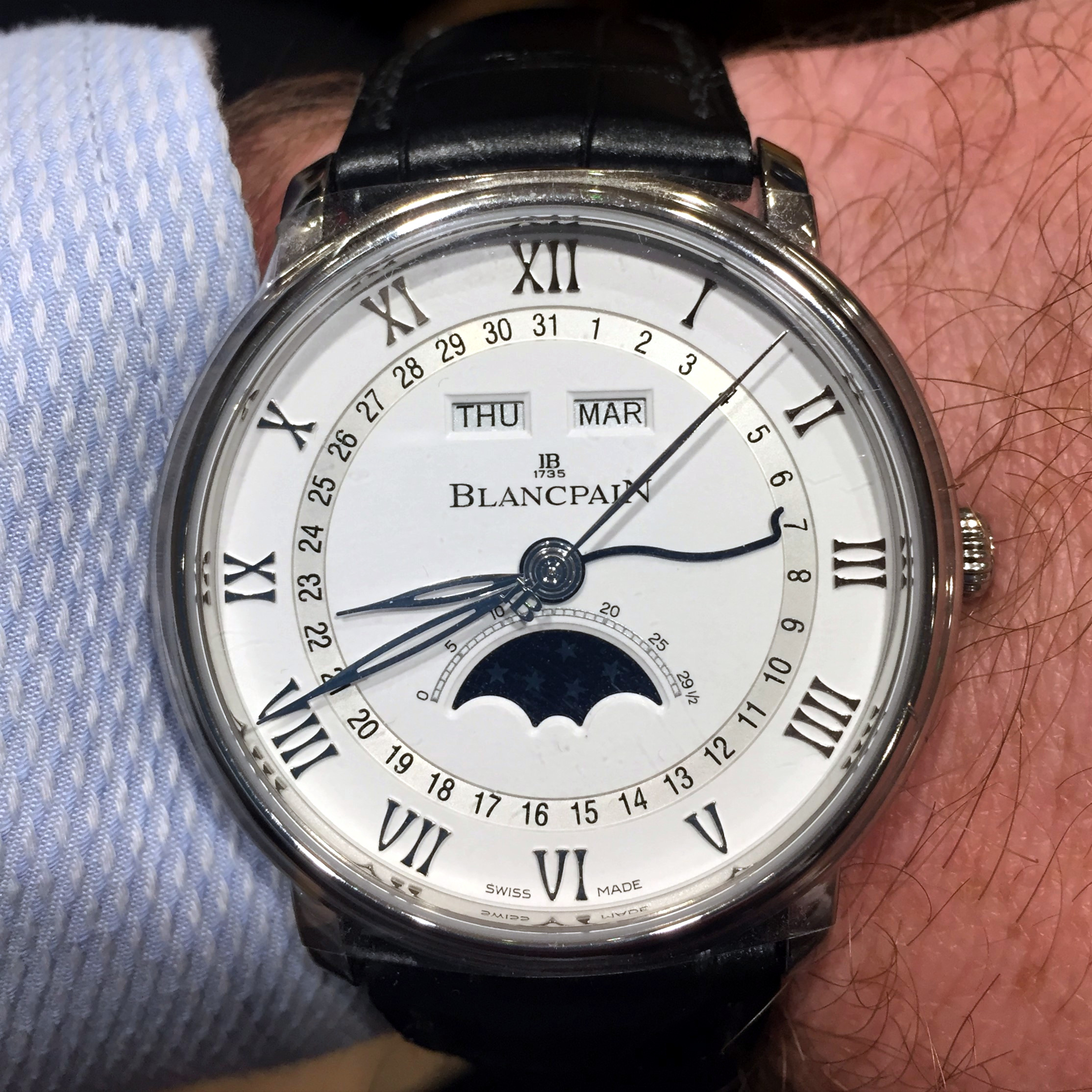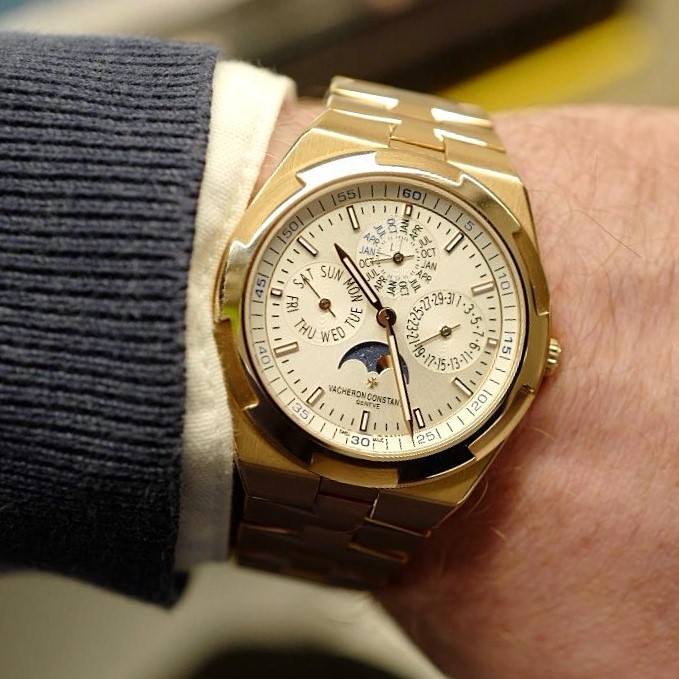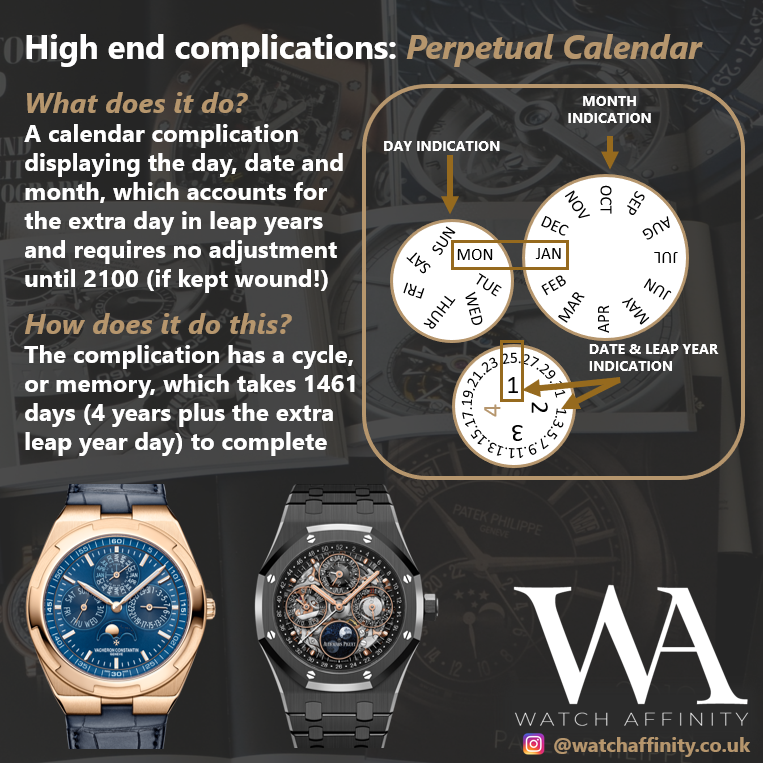In part 1 of our “It’s Complicated” series, we looked at the famous tourbillon. You can check out that post here. Next up, let’s take a look at the perpetual calendar…
One genre of complication you will often find on a timepiece is to do with the calendar. Whilst we might measure time in the short term in hours, minutes and seconds, this can be scaled up to days, weeks, months, and years, and so it becomes easy to see how and why certain timepieces would seek to incorporate this into their displays.
The Perpetual Calendar
Calendar complications range from the simple to the complex: at their most simplistic we find date displays, which are manually adjusted 5 times per year where a month is less than 31 days; day-date displays with the date and day of the week; complete calendars with the date, day, month and moon-phase, again requiring manual adjustment 5 times per year; annual calendars which account for months with different lengths except for February, and so only need be adjusted in leap years… and finally, the most complex of calendar complications, the perpetual calendar which accounts for the dates automatically, even for leap years, with no adjustment required.
You can see some examples of these different levels of calendar complications below:

Chopard Alpine Eagle - note the date aperture between 4 and 5 o'clock

Blancpain Villeret - note the day, date, month and moon phase

Vacheron Constantin Overseas Perpetual Calendar - note the additional leap year indicator in the sub-dial at 12 o'clock showing L
It is worth highlighting here that technically it is incorrect to state that perpetual calendar timepieces do not require updating – with calendar cycles based on the Julian Calendar and not the Gregorian Calendar, leap years need to be skipped three times in four centuries, and so a perpetual calendar timepiece will eventually need to be manually adjusted, but the next occasion for this is not until the year 2100, so for most of us it probably won’t be an issue!
To help try and illustrate the varying degrees of complexity of these calendar complications, we can think of them as having a different length of “cycle”, or maybe a “mechanical memory” of varying degrees.
For date, day-date and complete calendar complications, manual adjustment is required for the date only, which essentially entails advancing a disc with the date display on it, showing the numbers 1 through to 31. At the end of a month with 30 days, this disc will need to be manually adjusted to advance one place in order to show 1 instead of 31. Owing to the fact that the day disc has 7 days, and the month disc 12 months, and neither of these are ever ‘skipped’, these particular displays don’t need adjusting as time marches onwards. Keeping this in mind, we can therefore think of date, day-date and complete calendar complications as having a cycle of 31 days.
For annual calendar complications, manual adjustment is also only required for the date, however as it knows the number of days per month, it only needs to be manually adjusted only once per year to account for February and its 28 (or 29) days. In this instance, with the complication accounting for months of various lengths, we can say that its cycle lasts 365 days or 1 year.
For a perpetual calendar, with a calibre which automatically accounts for February having only 28 days for 3 in every 4 years, and 29 days each leap year, it must therefore have a cycle which lasts for an incredible 4 years plus the additional leap year day, which in total comes to an incredible 1461 days.
With the perpetual calendar complication cycle lasting more than 52 times longer than a simple date display, one can start to imagine the engineering complexity that goes into such a movement, and the skill required to assemble each of the 300 or more tiny component parts.
Additionally, it can be a real challenge for the manufacturers even just to display this additional information on a timepiece, with functions including hours, minutes, seconds, day, date, month, leap year indicator, and in many instances a moon phase too, with the dial easily becoming cluttered or illegible. Some timepieces from high-end manufacturers may not even stop there, with other complications such as chronographs not an irregular accompaniment!
The perpetual calendar complication is without doubt the ultimate display of watchmaking within calendar display complications. The sophistication of the calibre to automatically adjust its date as required, and not require manual adjustment for a century or longer by even accounting for leap years, is what makes this complication a real collectors’ item. Of course, the more complicated these calendar timepieces become, it does become increasingly important to keep them sufficiently wound and so it might be a wise time to invest in a watch winder!
To try and help illustrate the fundamental displays of the perpetual calendar as clearly as possible, we have created an infographic to serve as a summary reminder:

For any questions, please get in touch via our Contact page, or via our Instagram.
You might also be interested in:
- “It’s complicated” Part 1: an introduction to the Tourbillon
- “It’s complicated” Part 3: an introduction to the Minute Repeater
- “It’s complicated”: Date displays and calendar complications
- Watch Stationery and Gift Ideas
- Watch Books, Watch Boxes and more at the Watch Affinity Shop on Amazon (commissions earned)
As an Amazon Associate, I earn from qualifying purchases – thank you for your support

